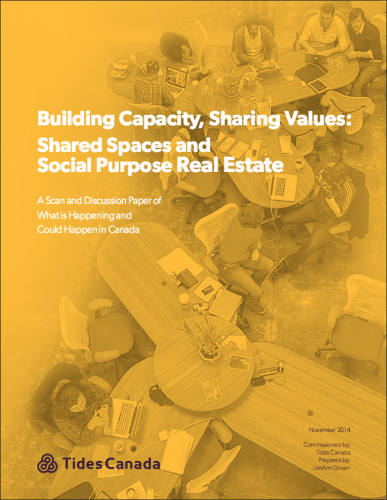A Scan and Discussion Paper of What is Happening and Could Happen in Canada
Building Capacity, Sharing Values: Shared Spaces and Social Purpose Real Estate has two interrelated components: a scan of current trends, activity, and capacity-needs in the rapidly-growing field of shared spaces and a discussion paper that looks at how learning on shared spaces could be nurtured and scaled across Canada.
This report weaves together a broad range of information on shared spaces, social purpose real estate, community infrastructure, and models for pan-Canadian learning and networking. The paper is structured around two overarching questions:
What is happening in the field of shared spaces?
In Sections 3-5, the scan identifies important trends, instructive examples, and key challenges and opportunities facing leaders and groups seeking to develop and sustain shared spaces and other social purpose real estate. The scan begins with a discussion of terminology related to shared spaces and summarizes the constellation of common players engaged in this model of social purpose real estate.
How best can learning on shared spaces and social purpose real estate be nurtured and scaled across Canada?
In Section 6, the scan draws on models of pan-Canadian networks to identify the challenges inherent in creating a new learning community. The paper concludes with a call for learning that focuses on social purpose real estate rather than the narrower model of shared spaces. In Section 7, the scan looks at options for bringing together capacity-building needs at two levels: practitioners and organizations engaged in projects; and stakeholders influencing the enabling environment of finance, policy, and leadership.
The appendices include a list of identified shared spaces, stakeholders consulted, learning topics, and recommended resources.
Of note: Although the mandate of the scan was a focus on shared spaces, the research embraced the broader concept of Social Purpose Real Estate (SPRE) as defined by the SPRE Collaborative in Vancouver: “property and facilities owned and operated by mission-based organizations and investors for the purpose of community benefit and to achieve blended value returns.”
The scan has identified that:
- Shared spaces are growing exponentially across Canada – the scan identified approximately 200 models where individuals and organizations are intentionally working together in a space that has articulated a mission and community purpose.
- Proponents face critical gaps in expertise, knowledge, and access to reliable technical expertise. Challenges include accessible and affordable information on real estate for nonprofit boards, availability of mission-oriented real estate expertise, and capacity to plan for all facets of operations including collaboration, asset management, and impact measurement. As detailed in Section 5, the interviews generated a wealth of strategies from simple information sheets to comprehensive training that can help meet these needs.
- Social purpose real estate projects have a still untapped potential to benefit from mainstream financing and from newer social finance tools and investment. Flexible pre-development support and patient capital sources were cited as the financial tools most needed for social purpose real estate initiatives to thrive.
- The development of projects, which typically happen one at a time, is not yet adding up to collective efforts to influence policies, awareness, and investment in community infrastructure.
- Shared space constitutes a distinct model but is too narrow a focus to scale learning and build support for community infrastructure.
- Nearly everyone interviewed expressed significant interest in pan-Canadian learning and a willingness to share information; however, without relevance to on-the-ground work and a clear value-add, this interest will not translate into a sustainable,
standalone network or platform. A fee-based membership model is particularly vulnerable to failure. - A learning community should not reinvent the wheel but should be a nimble network of networks bringing together the best of pan-Canadian and international learning in key areas like finance, collaboration, social enterprise, and nonprofit capacity.
Download Building Capacity, Sharing Values
Listen to the research webinar
View the research presentation
Table of Contents
| 1.0 Introduction | |
| 2.0 Background to the Scan | |
| 3.0 What is Shared Space? | |
| 3.1 A Bit About Terminology | |
| 3.2 Shared Spaces Sound Great But…Are They Making a Difference? AND Allowing More Dollars for Impact? | |
| 3.3 A Scrapbook: Shared-Spaces in Canada | |
| 4.0 Trends Influencing the Emergence and Spread of Shared Spaces | |
| 5.0 Overview of Challenges and Opportunities in Shared Spaces | |
| 5.1 Proponent Capacity | |
| 5.2 Financial Capacity | |
| 5.3 Enabling Environment Challenges and Opportunities | |
| 6.0 Towards a Pan-Canadian Learning Strategy | |
| 6.1 Pan-Canadian Networks and Associations: Some Observations | |
| 6.2 Reflections on Pan-Canadian Models of Learning and Exchange | |
| 6.3 Principles of a Pan-Canadian Learning Community | |
| 7.0 What Next? Getting to Options | |
| 7.1 Options for Form that Follows Function | |
| 7.2 What Next? Recommendations by Timeframe | |
| Appendices | |
| Appendix A: Sites Visits and Interviews | |
| Appendix B: Canadian Shared Spaces Identified through Scan | |
| Appendix C: Canadian and International Associations Reviewed | |
| Appendix D: Topics and Tools Requested by Interviewees | |
| Appendix E: A Dozen Shared Spaces at a Glance – East to West | |
| Appendix F: Resources Identified | |
Format
Source





